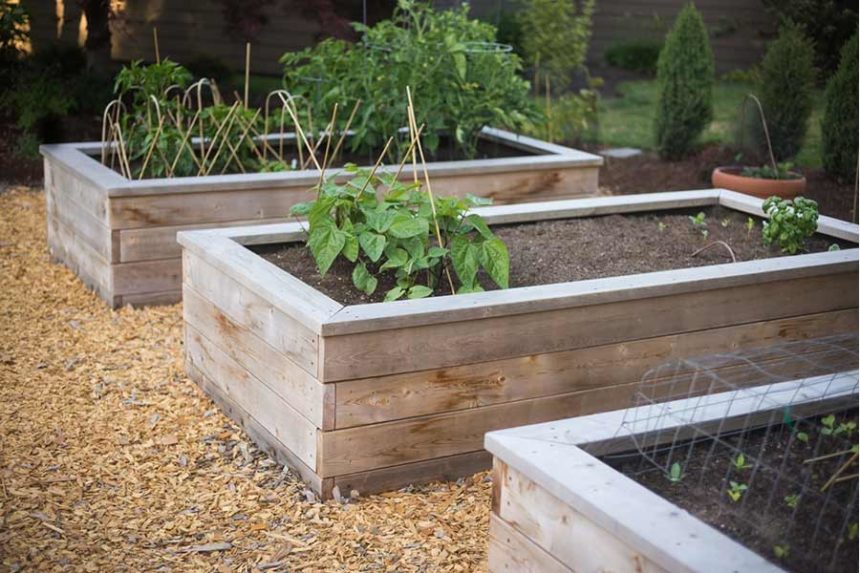A raised garden bed is a productive use of space and here’s how you build one
Published at
Building a raised bed garden box is a terrific way to create a productive garden space, especially if you have poor soil or limited space.
The first step is determining the best location for your raised beds. Select a spot that receives plenty of sunlight and has good drainage. You will want to avoid areas that are prone to flooding. Close access to a water source is also a consideration. A water hydrant or access to an irrigation system is necessary for effective garden production.
Size and shape
Your “why” of raised beds will help you determine the size and shape of the garden. Why are you utilizing raised beds? If it is because your health will not allow you to bend and stoop to garden, then the height of the raised bed will increase to comfortably allow you garden. For most individuals, 24-inches is the maximum height for a raised bed. Understand that the cost of materials increases with every inch increase in height. You must fill the garden box with filler material and soil, the higher the box the more you will need to fill.
If your “why” is poor soil drainage, consider a lower height for the raised bed. This is most economical and achieves the purpose of the raised bed. Most raised beds require at least 6-12 inches of soil depth, but some crops like carrots and potatoes require deeper soil. The main idea is to provide enough space for the root system of the plants you plan to grow.
The width of the raised bed is also a consideration. Raised beds should not be greater than four feet wide. One goal of raised bed gardening is to reduce compaction so soil structure can be improved. If the bed is more than four feet wide, you have to step into the bed to reach the center. The size of the raised bed is personal preference based on your gardening goals.
The shape of the raised bed is also a matter of personal preference. Most of the raised beds I have seen are rectangular, but I have also seen “U-shaped” raised beds. I encourage you to evaluate your garden space and use it as efficiently as possible. Crop rotations should be something that consistently happens every year. Rotating crops builds soil health. A three-year rotation for garden crops builds soil health.
Raised bed materials
When choosing materials for building your raised bed, consider durability, toxicity, environmental impact, affordability, aesthetics, maintenance requirements, and how permanent or portable you want your raised bed to be.
Many gardeners choose to use recycled materials to build a raised bed. One example is rusted out water troughs. They provide the structure, last long, are affordable, and can be aesthetically pleasing. These and other free or low-cost materials can be found at salvage yards, on social media marketplace sites, or even in your own backyard.
Another low-cost method of building raised beds is a bed without borders. You can create these by building a mound of straw and soil directly on top of the existing grown. This method is a favorite of permaculturists as it builds nutrients and adds tilth to impacted land. If you are trying to avoid toxins, this method might be your best option.

If you are planning to build a raised bed with wood, some types of wood are better than others. Redwood and cedar are excellent choices as they are more resistant to rotting than other woods. Pressure treated lumber is not a good option. Most pressure treated lumber is treated with chromated copper arsenate. CCA treated lumber will have staple-like indentations and a greenish tint. You want to avoid the use of this as the arsenic inside the wood will migrate into the soil.
If you use natural wood to build your bed, use natural wood treatments like flaxseed oil or wax. Linseed oil can contain toxic additives, so it is best to avoid it. There are a wide variety of borate-based washes that can be used which are safer to use near plant foods.
Common materials for raised beds

Filling a raised bed
Filling a garden box involves more than just dumping soil into it. You want to create a balanced environment for your plants to thrive. Some items to have on hand include topsoil, compost, aged manure, a garden fork or shovel, and water.

Start by adding a layer of organic matter to the bottom of the garden box. This can include compost, aged manure, shredded leaves, or other organic matter. This layer will increase soil fertility and improve drainage.
Next, add a mixture of equal parts topsoil and compost. Many gardeners will include other amendments like vermiculite or perlite to increase drainage. Use the garden fork to mix the soil and compost to evenly distribute the nutrients throughout the garden box.
Once you have mixed the soil, level the surface and water thoroughly. Watering will settle the soil, helping you to know if you need to add more soil.

In the Garden is sponsored by ProPeat, which is dedicated to delivering solutions for any of your professional fertilization needs. Whether you need to reduce the harm to soils and the environment, or you're interested in the latest nitrogen, carbon and biochemical technologies, ProPeat is the perfect fit.


